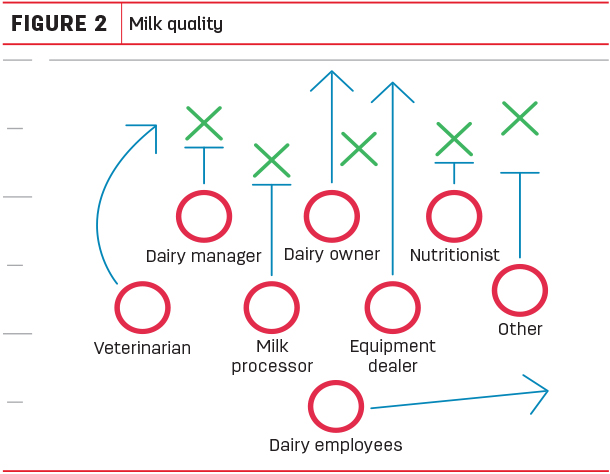What makes a team successful? There are a lot of factors, but one critical piece is having the right players in the right positions to achieve your goals. The same goes for the milk quality team on your dairy.
Producing high-quality milk in a profitable way is dependent on how each employee performs in their given role.
Here are some tips for managing your team to produce the best quality milk possible:
Draft and retain your team
Having the right team members is crucial to successful parlor management. Each team member must be able to work together to produce high-quality milk.
When hiring new team members, they need to understand their role in helping achieve your dairy’s milk quality goals. More importantly, new players must be able to work with your existing team. It’s better for employees to be a good fit and need training than be talented but not a team player.
Sometimes, trades or cuts to your team will be necessary. Make sure to have farm policies in place and that all employees understand them to ensure decisions are made fairly.
When building your team, don’t forget about the people you partner with such as your dairy manager, veterinarian, nutritionist and milking equipment dealer.
Develop plays
It’s important to have written job descriptions and protocols for each job position. Employees should clearly understand their role and how it impacts the quality of milk produced on your dairy (Figure 1). Outline roles for udder preparation, mastitis protocols, cleaning procedures and other parlor management responsibilities.

Include a schedule of when tasks should take place – at the start of milking, start of each cow group or wash times. With a set schedule, everyone’s aware of the expectations to help keep your dairy producing quality milk.
Consider establishing processes for cow movement, operator procedures and milking time. Operator routines are important to:
- Maximize parlor throughput
- Provide milking efficiency
- Maintain udder health
- Preserve milk quality
Practice, practice, practice
The next step is to put your plays into action (Figure 2).
 Training, coaching and communicating about what’s going well and what could use some fine-tuning is essential to leading a team that produces quality milk. Parlor managers and shift leaders must lead by example to show other employees the standard for success through the leadership of their parlor manager.
Training, coaching and communicating about what’s going well and what could use some fine-tuning is essential to leading a team that produces quality milk. Parlor managers and shift leaders must lead by example to show other employees the standard for success through the leadership of their parlor manager.
It’s also a good practice to meet with your employees on a regular basis, not just when milk quality issues arise. Having set meetings gives your staff the opportunity to communicate and have their voice heard.
Identify milk quality goals
Milk quality goals can only be obtained when they are clearly identified and defined. When your team is aware of the goals, it will be easier for them to work together to achieve them.
Make sure the goals you set are measurable. Key performance indicators (KPIs) can help measure goals and keep your team motivated.
When evaluating milk quality and udder health, somatic cell count (SCC) is the most basic KPI to track. Consider the following benchmarks when making your milk quality goals:
-
Bulk tank SCC: Develop a goal that makes sense for you and your dairy, knowing your quality premiums.
-
Individual cow SCC: Track the percent of your herd under 200,000 cells per milliliter.
-
Percent clinical mastitis hospital cows: Less than 2 percent is a good goal, less than 1 percent is elite
- Parlor timing and efficiency: Know the expectations of when shifts start and end. The performance required helps keep everything on track from the parlor to the crew taking care of and moving cows in the barns.
When goals get off track, avoid implementing a shotgun approach or quick fix to get back on track. Take a step back, evaluate what has changed and work as a team to find a solution.
Track progress
Regular milk quality assessments can help evaluate your progress and goals to help ensure you stay on track for success.
An evaluation plan should include the following steps:
-
Define: Identify the processes. Describe the procedures and routines.
-
Measure: Create a list of key areas you can measure. Establish how you’re going to measure them.
- Improve: Target industry standards or your on-farm benchmarks. Prioritize your action items. Begin implementation.
Keep the following areas in mind when you complete a milk quality evaluation:
-
Cows: teat ends; udder, feet and leg hygiene scoring; mastitis
-
Equipment: scheduled service, performance testing, cleaning
-
People: procedures, teat cleanliness, timing, liner and milker unit cleanliness, teat dip coverage, unit attachment and alignment, cow handling
- Environment: freestall alley and bedding cleanliness, ventilation
Performing regular milk quality evaluations with your team can help determine areas to make improvements. But evaluation alone doesn’t improve milk quality. Your team must be ready to make changes to get back on track (Figure 1). Everyone involved must know their role and be willing to take ownership to implement change.
Milk quality starts with having the right players in the right position on your team (Figure 2). And remember, your team extends beyond your parlor employees. Work with your dealer’s milk quality and hygiene specialist to implement these tips for a happy team and high-quality milk production. ![]()

-
Keith Engel
- Dairy Farm Hygiene and Supplies Specialist
- GEA
- Email Keith Engel







